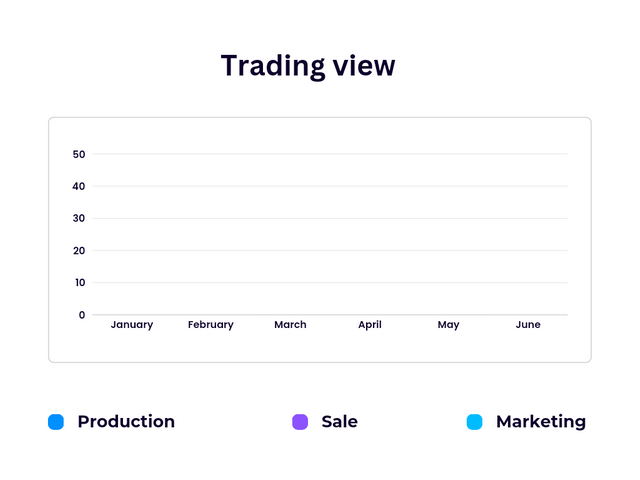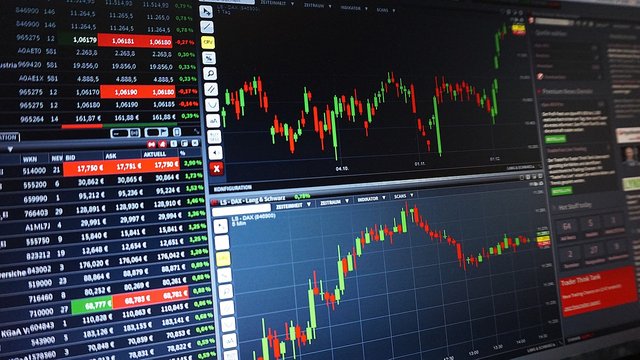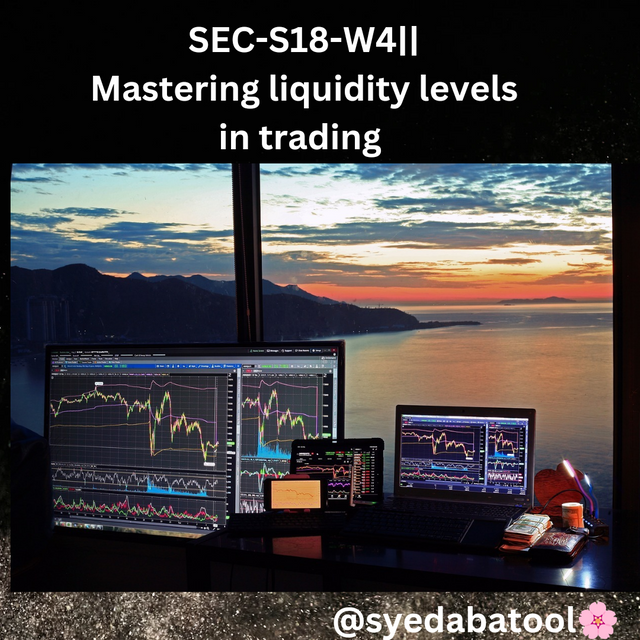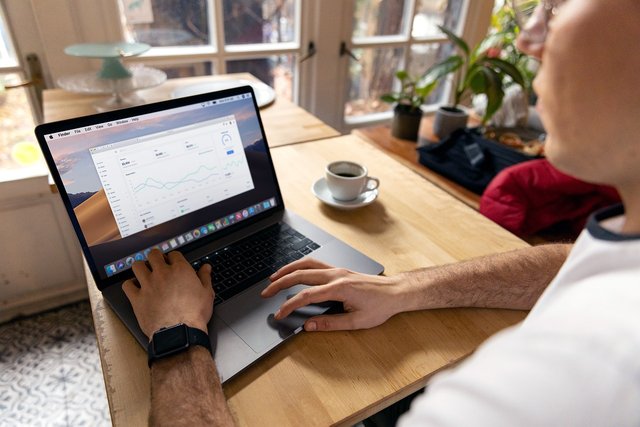My dear steemian fellows! I am @syedabatool from Pakistan 🇵🇰. Today I participate in the contest that is organized by "@crypto-academy".The topic of contest that is "SEC - S18-W4 : Mastering Liquidity Levels in Trading " . It's amazing contest.so, without wastage of time let's start.
Describe the concept of liquidity levels in trading. Why are they important for traders? What indicators or tools are used to identify these levels on a price chart?
Liquidity levels in trading refer to specific price levels where there is a significant amount of buy and sell orders. These levels are crucial because they indicate areas where traders can expect higher trading volumes and less price volatility, making it easier to enter and exit positions without causing large price movements.
Importance of Liquidity Levels for Traders:
Lower Transaction Costs:
High liquidity generally leads to tighter bid-ask spreads, reducing the cost of trading.
Better Price Stability:
Liquidity levels often act as support or resistance levels, providing more predictable price movements.
Indicators and Tools to Identify Liquidity Levels on a Price Chart:
Volume Profile:
This tool shows the traded volume at each price level over a specific period. Peaks in the volume profile indicate high liquidity levels.
Heat Maps:
Visual representations of the order book, showing where large volumes of orders are clustered at different price levels.
What is a fakeout in the context of liquidity levels? Explain why and how traders are often trapped by fakeouts.
A fakeout, in the context of liquidity levels, occurs when the price of an asset temporarily moves past a support or resistance level (often identified as a high liquidity area) but then quickly reverses direction. This movement can trick traders into entering trades in the wrong direction, leading to potential losses.
Why Traders Are Often Trapped by Fakeouts:
Misleading Signals:
Traders might interpret the initial break of a liquidity level as a strong signal that the price will continue in that direction. However, the subsequent reversal traps these traders in losing positions.
Market Manipulation:
In some cases, fakeouts are caused by market manipulation where large players create false breakout scenarios to induce retail traders into taking positions that they can then exploit.
How Fakeouts Trap Traders:
Breakout Traders:
Traders who enter positions when the price breaks through support or resistance levels can be caught if the price quickly reverses after the breakout, leading to losses.
Stop-Loss Orders:
Traders often place stop-loss orders just beyond support or resistance levels. A fakeout can trigger these stop-loss orders, resulting in traders being stopped out at a loss.
Describe an effective strategy for trading liquidity levels correctly. What signs or confirmations should traders look for before taking a position based on a liquidity level?
An effective strategy for trading liquidity levels involves careful analysis and confirmation to ensure that trades are based on reliable signals rather than potentially deceptive movements like fakeouts.
Steps to Trade Liquidity Levels:
Identify Key Liquidity Levels:
Support and Resistance:
Determine significant support and resistance levels by analyzing historical price action where the price has reversed multiple times.
Volume Profile:
Use the volume profile tool to identify price levels with high trading volumes, indicating strong liquidity.
Moving Averages:
Check if the price is aligned with significant moving averages (e.g., 50-day or 200-day MA) as these often act as dynamic support or resistance.
Stop-Loss:
Place stop-loss orders slightly beyond the liquidity level to protect against fakeouts and minimize potential losses.
Signs and Confirmations to Look For:
Successful Retest:
The price breaks through a liquidity level, then returns to test it, and holds this level, indicating it has turned into new support or resistance.
Price Action:
Look for consolidation or a range before the breakout, followed by a decisive move through the liquidity level.
High Volume on Breakout:
A significant increase in trading volume during the breakout confirms strong market interest.

What are some tips and techniques to avoid fakeouts when using a trading strategy based on liquidity levels? Give a concrete example with detailed steps.
Tips and Techniques to Avoid Fakeouts in Liquidity Level Trading:
Volume Analysis:
Ensure that the breakout is accompanied by a significant increase in volume. Low volume breakouts are more likely to be fakeouts.
Wait for Retest:
Before entering a trade, wait for the price to break a liquidity level and then retest it. A successful retest provides a stronger confirmation that the level has truly been broken.
Avoid Low Liquidity Times:
Fakeouts are more common during periods of low liquidity, such as during the early hours of the trading session or during holidays. Avoid trading during these times.

Source
Concrete Example with Detailed Steps:
Wait for a Breakout:
The price breaks above $150 and closes at $152. Before entering a trade, you wait for further confirmation.
Enter the Trade:
With the confirmation from the retest, volume, candlestick pattern, and additional indicators, you enter a long position at $153.
Analyze a chart of a crypto asset of your choice, including the Steem token, to identify liquidity levels. Describe a potential trade based on these levels by explaining your reasoning and the steps you would take to enter and exit the position.
Identify Key Liquidity Levels:
Support and Resistance:
By analyzing historical price action, you determine that $0.30 is a strong support level and $0.45 is a significant resistance level for Steem.
Volume Profile:
Using the volume profile tool, you notice high trading volumes around $0.30 and $0.45, which confirms these levels as important liquidity areas.
Wait for a Breakout or Breakdown:
Assume Steem is currently trading at $0.35 and is approaching the resistance level at $0.45. You wait to see if it will break above $0.45 (indicating a potential bullish move).
Stop-Loss:
Place a stop-loss order slightly below the $0.45 level, around $0.42, to protect against a potential fakeout.
Take-Profit:
Set an initial take-profit target at the next significant resistance level, which could be around $0.60, based on historical price action.
I invite my friends to participate in the contest
@muhammad-ahmad , @ankit64 , @justiceanietie , @bonaventure24 , @huraira50 @hive-180106 , @basil20 .




It's true that fakeout can lure traders to take a wrong trade while the market reverse to it original direction.
My advice is for traders to be patient and wait for the price to reach the supply or demand zone, at this point you stand a chance of taking a better trade and this will minimize lose in your journey of trading.
Wishing you all the best of luck.
Downvoting a post can decrease pending rewards and make it less visible. Common reasons:
Submit
Thanks 😊 for comment
Downvoting a post can decrease pending rewards and make it less visible. Common reasons:
Submit
Welcome 🤗
Downvoting a post can decrease pending rewards and make it less visible. Common reasons:
Submit
Hello @syedabatool!
What an insightful and comprehensive post on mastering liquidity levels in trading! Your explanation of how liquidity levels impact transaction costs and price stability is spot-on. It’s essential for traders to understand these concepts to make informed decisions and reduce risks in volatile markets.
Your detailed breakdown of tools like the Volume Profile and Heat Maps to identify these levels on price charts is incredibly useful. Additionally, the strategies to avoid fakeouts, such as analyzing volume and waiting for retests, are practical tips that can save traders from potential losses.
Recent data highlights the importance of liquidity. For example, in April 2024, stock market liquidity facilitated $2.5 trillion in daily trades, emphasizing the need for efficient trading environments . Understanding liquidity levels can help traders navigate these massive volumes with more confidence.
Moreover, your step-by-step example of trading the Steem token with identified liquidity levels provides a clear roadmap for applying these concepts in real-world scenarios.
Thank you for mentioning me! Let's continue to share and grow our knowledge together.
For those reading, if you found this post helpful, please follow @ankit64 and upvote for more insightful content!
With best regards
@ankit64
Downvoting a post can decrease pending rewards and make it less visible. Common reasons:
Submit
Avoid early hours trade is one of the good option to not get trapped in fakeout. However, if early analysis is clear then it can be one of the good chance also to trade for opposite direction. Nice publication entry.
Downvoting a post can decrease pending rewards and make it less visible. Common reasons:
Submit
Thanks 😊
Downvoting a post can decrease pending rewards and make it less visible. Common reasons:
Submit
Each of your analyzes is truly one of the most remarkable liquidity levels you have ever written. They are really important for every traders because without them the market analysis is impossible. These actually give us direction and it is very important to take action accordingly. If we can get out of fake out then we will not have number of losses. Best of luck to you.
Downvoting a post can decrease pending rewards and make it less visible. Common reasons:
Submit
Thanks for your valuable comment 🤌
Downvoting a post can decrease pending rewards and make it less visible. Common reasons:
Submit
Unfortunately @syedabatool, you are not eligible to participate in this competition, you must at least belong to club5050.
Downvoting a post can decrease pending rewards and make it less visible. Common reasons:
Submit
Hello dear @kouba01 can you please share the telegram bot link for checking the club status or to check stats of the account. I'm very grateful to you. Thank you
Downvoting a post can decrease pending rewards and make it less visible. Common reasons:
Submit
Hi @kouba01
Now, I have joined the club , so I eligible for this competition
Downvoting a post can decrease pending rewards and make it less visible. Common reasons:
Submit
Hi Dear you share such a good information but unfortunately you lost your club status so you need to join at least club 5050 and participate in other contest Best of luck for Next
Downvoting a post can decrease pending rewards and make it less visible. Common reasons:
Submit
Greetings my friend @syedabatool,
This is fantastic! Your explanation of how liquidity levels impact transaction costs and price stability is so spot-on. It's essential to know these concepts for better trading!
Downvoting a post can decrease pending rewards and make it less visible. Common reasons:
Submit
Yes 🥰
Downvoting a post can decrease pending rewards and make it less visible. Common reasons:
Submit
Greetings,
Thanks for breaking down those trading tips in simpler terms. Your explanation really helps in understanding how to steer clear of fakeouts in trading based on liquidity levels. I appreciate the insights.
Downvoting a post can decrease pending rewards and make it less visible. Common reasons:
Submit
Thanks 😊
Downvoting a post can decrease pending rewards and make it less visible. Common reasons:
Submit
Desafortunadamente no estás en el club5050, es un requisito indispensable.
Gracias por el esfuerzo realizado para elaborar tu contenido.
Saludos y mucha suerte.
Downvoting a post can decrease pending rewards and make it less visible. Common reasons:
Submit
Now I have joined club5050 😊
Downvoting a post can decrease pending rewards and make it less visible. Common reasons:
Submit